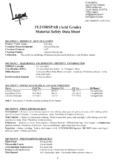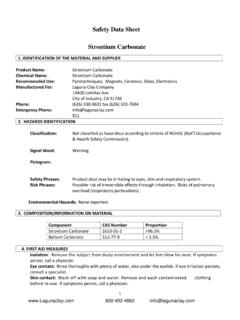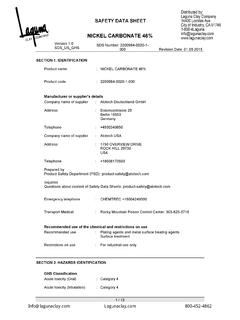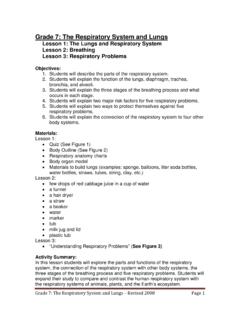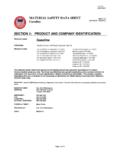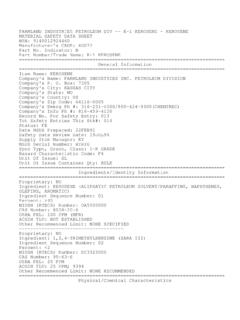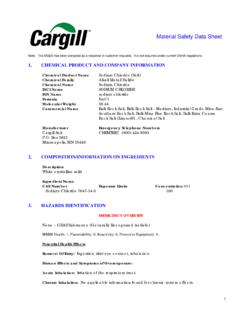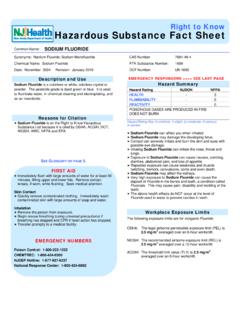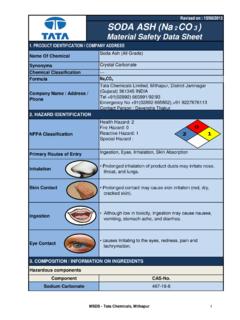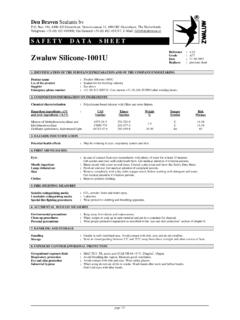Transcription of Magnesium Oxide Material Safety Data Sheet - …
1 Material Safety data Sheet Date Prepared: 10/10 This Revision: CHEMTREC, 24-Hr Emergency Assistance: 1-800- 424- 9300 SECTION 1. CHEMICAL PRODUCT AND COMPANY IDENTIFICATION Material / Product Name(s): MAGOX 93 HR 325 CAS Number: 1309-48-4 Chemical Family: Mineral Oxide General Use: A chemical grade Magnesium Oxide powder. Manufacturer / Supplier: Laguna Clay Company14400 Lomitas AveIndustry, CA 91746 SECTION 2. INGREDIENTS / COMPOSITION Ingredient name: CAS Number: Percent: IARC/NTP/OSHA: Exposure Limits: Calcined Magnesite 1309-48-4 100 No Nuisance Particulate OSHA ( Magnesium Oxide ) PEL:TWA 15mg/m3;respirable: 5mg/m3.
2 ACGIH TLV:TWA Total dust:10mg/m3; respirable dust: 5mg/m3. Quartz* (SiO2) 14808-60-7 0-1 Yes ACGIH TLV:TWA repirable quartz Typical Chemical Analysis, (Loss Free Basis) LOI (1000 C) Acid Insol R2O3 CaO MgO The oxides shown in the typical chemical analysis do not exist in the Magnesium Oxide as free, uncombined oxides, but are combined mineralogically as calcium- Magnesium silicates, aluminates and ferrites. *Quartz. Product may contain a trace of quartz, a polymorph of crystalline silica, which is classified by IARC as a Known Human Carcinogen - Gro up 1.
3 NTP lists respirable crystalline silica amongst substances which may reasonably be anticipated to be carcinogens . SECTION 3. HAZARDS IDENTIFICATION HMIS HEALTH HAZARD 1 - SLIGHT FLAMMABILITY HAZARD 0 - MINIMAL REACTIVITY HAZARD 1 - SLIGHT PERSONAL PROTECTION B - Glasses, Gloves EMERGENCY OVERVIEW: A brownish, free flowing, fine granular Material . Not a fire or spill hazard. Contact with water may cause product to swell, generate some heat, and burst its container. Low toxicity. Dust is classified as a nuisance particulate not otherwise regulated . Target Organs: Chronic overexposure may cause lung damage.
4 Primary route(s) of entry: Inhalation Acute effects: Particulate may cause eye and upper respiratory irritation. Page 1 --- HAZARD IDENTIFICATION continues on page 2 --- Page 1 Clay Company800-452-4862 Material Safety data Sheet PREMIER MAGNESIA MSDS No.: 2621 Date Prepared: 10/10 Phone: PREMIER MAGNESIA: 1- 800- 227- 4287 This Revision: CHEMTRAC, 24-Hr Emergency Assistance: 1-800- 424- 9300 HAZARD IDENTIFICATION continued from page 1 Chronic effects: Product dust is classified as a nuisance particulate, not otherwise regulated as specified by ACGIH and OSHA.
5 The excessive, long-term inhalation of mineral dusts may contribute to the development of industrial bronchitis, reduced breathing capacity, and may lead to the increased susceptibility to lung disease. Signs & symptoms of overexposure: Eye contact: Particulate is a physical eye irritant. Skin contact: Low toxicity by skin contact. Inhalation: Chronic overexposure by inhalation of airborne particulate may irritate upper respiratory system as well as the throat. Ingestion: An unlikely route of exposure. If ingested in sufficient quantity, may cause gastrointestinal disturbances.
6 Symptoms may include irritation, nausea, vomiting and diarrhea. SECTION 4. FIRST AID MEASURES Eye contact: Flush eyes, including under the eyelids, with large amounts of water. If irritation persists, seek medical attention. Skin contact: Wash affected areas with mild soap and water. Inhalation: Remove victim to fresh air. If not breathing, give artificial respiration. Get immediate medical attention. Ingestion: Ingestion is an unlikely route of exposure. If ingested in sufficient quantity and victim is conscious, give 1-2 glasses of water or milk. Never give anything by mouth to an unconscious person.
7 Leave decision to induce vomiting to qualified medical personnel, since particles may be aspirated into the lungs. Seek immediate medical attention. SECTION 5. FIRE FIGHTING MEASURES NFPA code: Flammability: 0 , Health: 1 , Reactivity: 1 , Special: 0 . Flash point: Not Combustible Unusual Fire Hazard / Extinguishing Media: Water reacts with Magnesium Oxide producing Magnesium hydroxide and heat. Do not allow water to get inside containers; reaction with water will cause product to swell, generate heat, and burst its container. If contact is unavoidable, use sufficient water to safely absorb the heat that may be generated.
8 Wetted product is not a health or environmental hazard. Hazardous Decomposition Products: None Firefighting Instructions: Firefighters should wear NIOSH-approved, positive pressure, self-contained breathing apparatus and full protective clothing when appropriate. SECTION 6. ACCIDENTAL RELEASE MEASURES Spill procedures: Carefully, clean up and place Material into a suitable container, being careful to avoid creating excessive dust from dried product. If conditions warrant, clean up personnel should wear approved respiratory protection, gloves, and goggles to prevent irritation from contact and/or inhalation.
9 SECTION 7. HANDLING AND STORAGE Storage: Store in dry, protected storage. Product is stable under normal conditions of dry storage. Do not allow water to get inside containers; reaction with water will cause product to swell, generate heat, and burst its container. Exposed, unprotected Magnesium Oxide will absorb moisture and carbon dioxide from the air. Minimize dust generation during Material handling and transfer. SECTION 8. EXPOSURE CONTROLS AND PERSONAL PROTECTION Engineering controls: Provide sufficient ventilation, in both volume and air flow patterns to control mist/dust concentrations below allowable exposure limits.
10 Page 2 --- EXPOSURE CONTROLS AND PERSONAL PROTECTION continues on page 3 --- Page 2 Clay Company800-452-4862 Material Safety data Sheet PREMIER MAGNESIA MSDS No.: 2621 Date Prepared: 10/10 Phone: PREMIER MAGNESIA: 1-800- 227-4287 This Revision: CHEMTRAC, 24-Hr Emergency Assistance: 1-800- 424- 9300 EXPOSURE CONTROLS AND PERSONAL PROTECTION continued from page 2 Personal protective equipment: The use of eye protection, gloves and long sleeve clothing is recommended. Respiration protection:Provide workers with NIOSH approved respirators in accordance with requirements of 29 CFR for level of exposure incurred.
